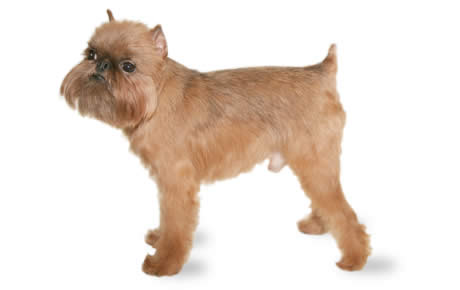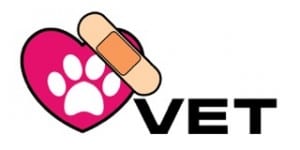Type the name of the breed you're looking for below
[wpdreams_ajaxsearchlite] Don't see the breed your're looking for? Click here and let us know!
Breed Characteristics
1 paw - breed exhibits the least amount of this characteristic
5 paws - breed exhibits most amount of this characteristic
Belgian Griffon
| Other Names | Griffon Belge, Griffon Bruxellois, Brussels Griffon, Petit Brabancon, Belgian Griffon, Griffon |
| Country of Origin | Belgium |
| Weight | 6 - 12 lbs. (2.5 - 5.5 kg) |
| Height (at withers) | 7 - 8 in. (18 – 20 cm) |
| Coat | There are two types of coats, rough and smooth. The rough coat is dense and wiry. On the smooth coat, also called the Petit Brabancon variety, the fur is short, tight, glossy and straight. The short coats are easier to groom. |
| Colour | Coat colours include red (reddish brown with a little black at the whiskers and chin), belge (a mixture of red-brown and black usually with black mask and whiskers), black and tan (black with reddish brown markings under the chin, legs, above each eye, the edges of the ears and around the vent), and solid black. |
| Litter Size | 1 - 3 puppies, average 2 |
| Life Span | 12 - 15 years |
| Origin & History | The three variations of this dog, the Brussels Griffon (Griffon bruxellois), the Belgian Griffon (Griffon belge), and the Petit Brabançon, all descend from an old type of dog called a Smousje, a rough coated, small terrier-like dog kept in stables to eliminate rodents, similar to the Dutch Smoushond. The little wire-haired dog in the foreground of the Jan van Eyck painting The Arnolfini Marriage is thought to be an early form of this breed. In Belgium coachmen were fond of their alert little Griffons d’Ecurie (wiry coated stable dogs) and in the 19th century, they bred their Griffons with imported toy dogs. Breeding with the Pug and King Charles Spaniel brought about the current breed type, but also brought the short black coat that led to the Petits Brabançon, which was originally a fault in the breed. The spaniels also brought the rich red and black and tan colour of the modern Griffon Bruxellois and Griffon Belge. The Griffon Bruxellois grew in popularity in the late 19th century with both workers and noblemen in Belgium. The first Griffon Bruxellois was registered in 1883 in the first volume Belgium's kennel club studbook, the Livre des Origines Saint-Hubert (LOSH). The popularity of the breed was increased by the interest of Queen Marie Henriette, a dog enthusiast who visited the annual dog shows in Belgium religiously, often with her daughter, and became a breeder and booster of Griffon Bruxellois, giving them international fame and popularity. Many dogs were exported to other countries, leading to Griffon Bruxellois clubs in England (1897) and Brussels Griffon clubs in the U.S.A. (1945.) The First World War and Second World War proved to be a disastrous time for the breed. War time is difficult on any dog breed, and the recovering numbers after the First World War were set back by increased vigilance in breeding away from faults such as webbed toes. By the end of the Second World War, Belgium had almost no native Griffon Bruxellois left, and it was only through the vigilance of dedicated breeders (in the U.K. particularly) that the breed survived at all. The breed has never been numerous or popular, but had a brief vogue in the late 1950s, and now is generally an uncommon breed. There has been a recent increase in interest in the United States due to appearance of a Griffon in the movie, As Good as It Gets, and also because of a general increase in interest in toy dogs. |
| Personality | The Griffon is an intelligent cheerful dog with a terrier-like disposition. With lots of personality, it makes a fine companion dog and is good with other dogs and cats. Affectionate, charming, lively and curious, they love everyone. The Griffon cannot live outside in a kennel. If you feed them table scraps, they may become greedy or picky eaters. May be difficult to housebreak. They make good watchdogs and can be taught to perform tricks. Because of this dog’s almost human looking facial expression, they have not only been nicknamed "monkey face," but are prone to being treated as if they are not dogs, but little humans. This causes something called Small Dog Syndrome. The dog begins to believe IT is the ruler of the home, and IT tells ITS humans what they can and cannot do. When a human allows a dog to take over the home, it causes varying degrees of behavior problems, including, but not limited to, willfulness, demanding, obsessive barking, guarding, separation anxiety, snapping and even biting. They may become untrustworthy with children and sometimes even adults. Without enough mental and physical exercise, they will become high-strung, moody and sensitive. These are NOT Griffon traits, but behaviors brought on by the lack of a firm, confident, consistent pack leader, who provides rules they must follow and limits as to what they are and are not allowed to do along with the right amount and type of exercise. |
Care Requirements
| Health | Health: Griffons have relatively few inherited health problems, but should still be tested for congenital defects, the most serious of which are Syringomyelia (SM) and Chiari-like malformation (CM). Birthing; Griffons usually have no trouble whelping on their own, but sometimes complications can cause a Caesarean section to be needed. The size of a litter is typically 1-3 puppies. The size of the litter often determines the extent of these complications. Litters of six are not unheard of. When they are born, the puppies only weigh but a few ounces and are small enough to fit in the palm of an adult's hand. It can get leg and heart problems from an early age. Cleft palate; One issue that is typically fatal for the puppies is having a cleft palate. It results in the puppy not receiving nourishment from the mother and eventually starvation. It is uncommon but, depending on the size of the cleft, it is possible for the puppy to survive where as it becomes older surgery can be done to close the hole. Eyes; Most have large eyes that may require rechecks from a veterinarian. Lacerations - Lacerations are a common issue amongst the breed. Because the Griffons have such large eyes and a short snout, there is very little there to protect their vision from foreign bodies. If a laceration is left untreated it can result in blindness. Cataracts - As with most breeds, cataracts are a common problem as the dog ages. For many breeders it is a disappointment that the cataracts typically develop long after the dog has already been bred. Lens Luxations - Lens luxations can be fairly common in the breed and result in secondary glaucoma Glaucoma - Glaucoma can also be a common issue amongst Griffons owing to the breed's facial features and eye size. Heat Stroke; Although Griffons have a shortened snout, heat stroke is not a major concern for them as it is with other flat-faced breeds. The breed's shortened muzzle may cause respiratory problems in extreme heat, but overall they tolerate both hot and cold weather well. As with any breed, owners must use common sense and not leave them outdoors without protection from the elements or subject them to rigorous exercise during extreme temperatures, so let them in your house for cool air and some water (ice-cold water is bad for dogs' stomachs). Syringomyelia; Syringomyelia (SM) is a condition affecting the brain and spine, causing symptoms ranging from mild discomfort to severe pain and partial paralysis. Syringomyelia is characterised by fluid filled cavities within the spinal cord. SM occurs secondary to obstruction of cerebrospinal fluid (CSF) especially if that obstruction is at the foramen magnum. To date the condition has been also reported in Cavalier King Charles Spaniels, King Charles Spaniels, Yorkshire Terriers, Maltese Terriers, Chihuahuas, Miniature Dachshunds, Miniature/Toy Poodles, Bichon Frisé, Pugs, Shih Tzus, Pomeranians, Boston Terriers, French Bulldogs, a Pekingese, a Miniature Pinscher, mixbreeds, and a couple of cats. Not all dogs with SM have clinical signs. The presence of signs is correlated to the width of the syrinx and extent of spinal cord dorsal horn damage. Syrinxes can progressively expand and a dog which is asymptomatic in early life may eventually experience pain. |
| Grooming | The coat of the rough requires a lot of attention, however the coat of the pet dogs may be clipped. The Griffon sheds little to no hair. |
| Exercise | These little dogs are very active indoors, however, like all dogs, they still need to be taken for a daily walk to fulfill their primal instinct to walk. |
| Other Considerations | Griffons are good dogs for apartment life and will do okay without a yard. Griffon Bruxellois in popular culture: The American impressionist painter Mary Cassatt kept Brussels Griffons and frequently portrayed them in her paintings. In the film As Good as It Gets (1997), as Verdell, played by six Brussels Griffons, named Timer, Sprout, Debbie, Billy, Parfait, and Jill the star. In the film Gosford Park, as Rolf Liechti's dog Kiki In the film Sweet November, as Sara's dog Ernie In the sitcom Spin City, as Carter's suicidal dog Rags, played by a smooth-coated Petit Brabançon named Wesley In the film Teaching Mrs. Tingle, as Mrs. Tingle's dog. Monkey, owned by record label owner and deejay Sarah Lewitinn and named "Best Dog Owned by a Club Personality" by The Village Voice Tazzie owned by Stanley Dangerfield, appearing on the television show The Good Companions In the film First Wives Club owned by Diane Keaton's character. In the sitcom "Mike and Molly" Mikes mom's dog, Jim is a Brussels Griffon mixed with a Chihuahua. The Southern California craft brewery "The Bruery" brewed a sour brown ale called Griffon Bruxellois. |



